NURSING 8: Restrictive Practices in Mental Health Nursing Care
VerifiedAdded on 2022/09/07
|12
|3231
|21
Essay
AI Summary
This essay delves into the contentious practices of seclusion and restraint within mental health settings, examining their impacts on both patients and healthcare professionals. The essay explores the adverse effects of these restrictive strategies, including potential trauma, human rights violations, and the compromise of patient-centered care. It highlights the perspectives of both patients and nurses, discussing the negative feelings associated with seclusion and restraint, and the challenges faced by healthcare providers. The role of registered nurses in mitigating these practices is emphasized, with a focus on the importance of documentation, patient advocacy, and the exploration of alternative interventions. The essay draws on national and international perspectives, providing a comprehensive analysis of the issue and advocating for the reduction of restrictive practices in favor of more therapeutic and patient-focused approaches.
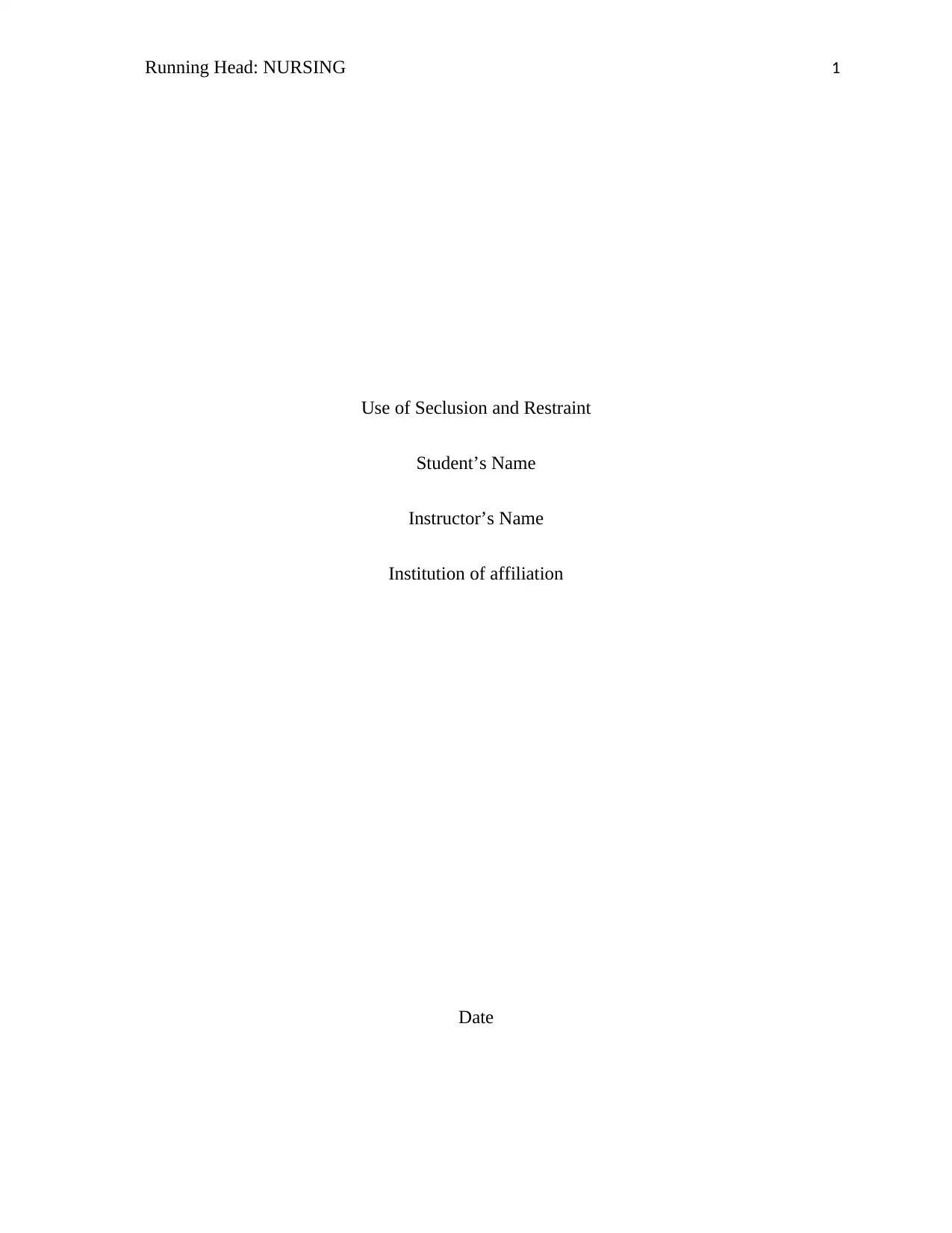
Running Head: NURSING 1
Use of Seclusion and Restraint
Student’s Name
Instructor’s Name
Institution of affiliation
Date
Use of Seclusion and Restraint
Student’s Name
Instructor’s Name
Institution of affiliation
Date
Paraphrase This Document
Need a fresh take? Get an instant paraphrase of this document with our AI Paraphraser
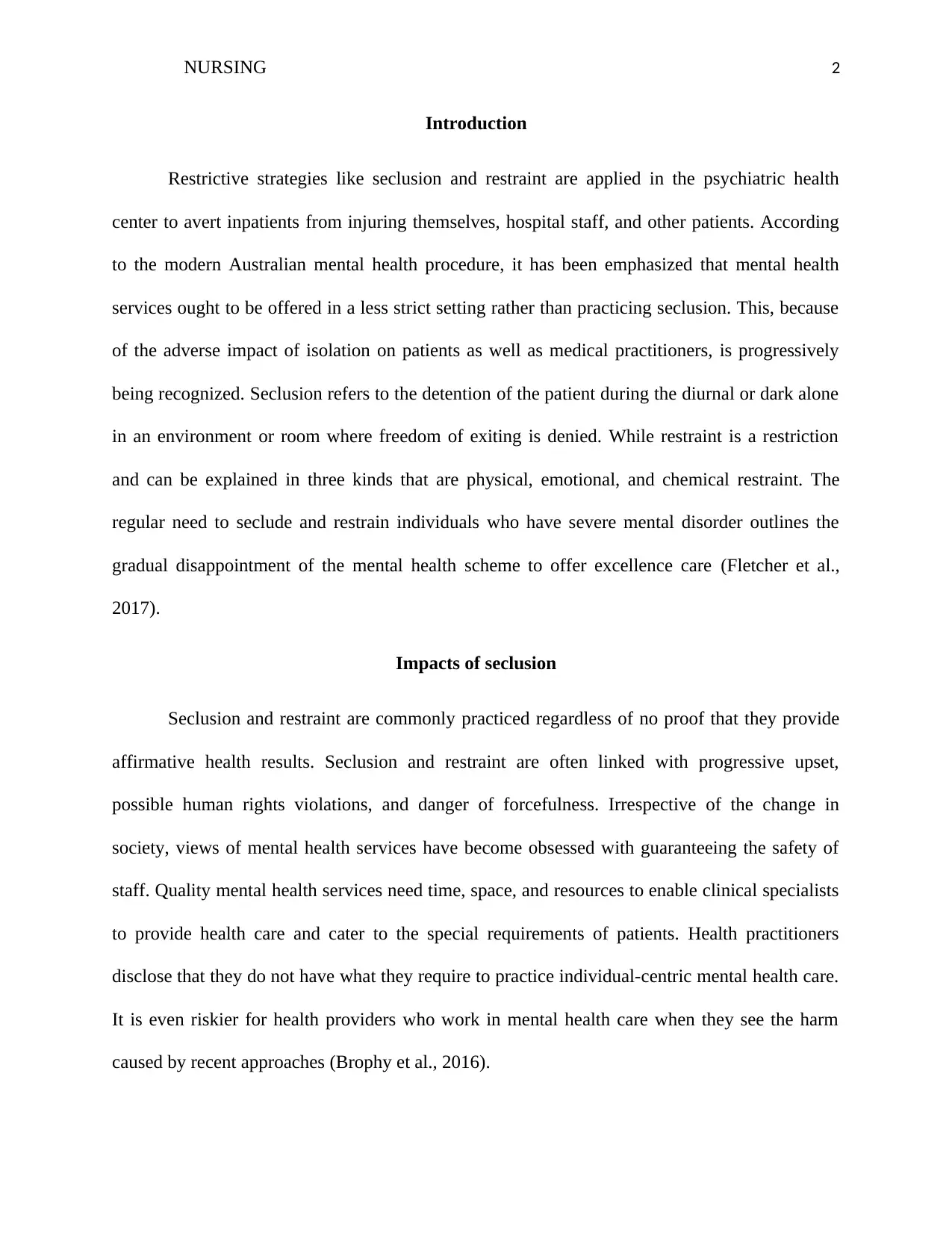
NURSING 2
Introduction
Restrictive strategies like seclusion and restraint are applied in the psychiatric health
center to avert inpatients from injuring themselves, hospital staff, and other patients. According
to the modern Australian mental health procedure, it has been emphasized that mental health
services ought to be offered in a less strict setting rather than practicing seclusion. This, because
of the adverse impact of isolation on patients as well as medical practitioners, is progressively
being recognized. Seclusion refers to the detention of the patient during the diurnal or dark alone
in an environment or room where freedom of exiting is denied. While restraint is a restriction
and can be explained in three kinds that are physical, emotional, and chemical restraint. The
regular need to seclude and restrain individuals who have severe mental disorder outlines the
gradual disappointment of the mental health scheme to offer excellence care (Fletcher et al.,
2017).
Impacts of seclusion
Seclusion and restraint are commonly practiced regardless of no proof that they provide
affirmative health results. Seclusion and restraint are often linked with progressive upset,
possible human rights violations, and danger of forcefulness. Irrespective of the change in
society, views of mental health services have become obsessed with guaranteeing the safety of
staff. Quality mental health services need time, space, and resources to enable clinical specialists
to provide health care and cater to the special requirements of patients. Health practitioners
disclose that they do not have what they require to practice individual-centric mental health care.
It is even riskier for health providers who work in mental health care when they see the harm
caused by recent approaches (Brophy et al., 2016).
Introduction
Restrictive strategies like seclusion and restraint are applied in the psychiatric health
center to avert inpatients from injuring themselves, hospital staff, and other patients. According
to the modern Australian mental health procedure, it has been emphasized that mental health
services ought to be offered in a less strict setting rather than practicing seclusion. This, because
of the adverse impact of isolation on patients as well as medical practitioners, is progressively
being recognized. Seclusion refers to the detention of the patient during the diurnal or dark alone
in an environment or room where freedom of exiting is denied. While restraint is a restriction
and can be explained in three kinds that are physical, emotional, and chemical restraint. The
regular need to seclude and restrain individuals who have severe mental disorder outlines the
gradual disappointment of the mental health scheme to offer excellence care (Fletcher et al.,
2017).
Impacts of seclusion
Seclusion and restraint are commonly practiced regardless of no proof that they provide
affirmative health results. Seclusion and restraint are often linked with progressive upset,
possible human rights violations, and danger of forcefulness. Irrespective of the change in
society, views of mental health services have become obsessed with guaranteeing the safety of
staff. Quality mental health services need time, space, and resources to enable clinical specialists
to provide health care and cater to the special requirements of patients. Health practitioners
disclose that they do not have what they require to practice individual-centric mental health care.
It is even riskier for health providers who work in mental health care when they see the harm
caused by recent approaches (Brophy et al., 2016).
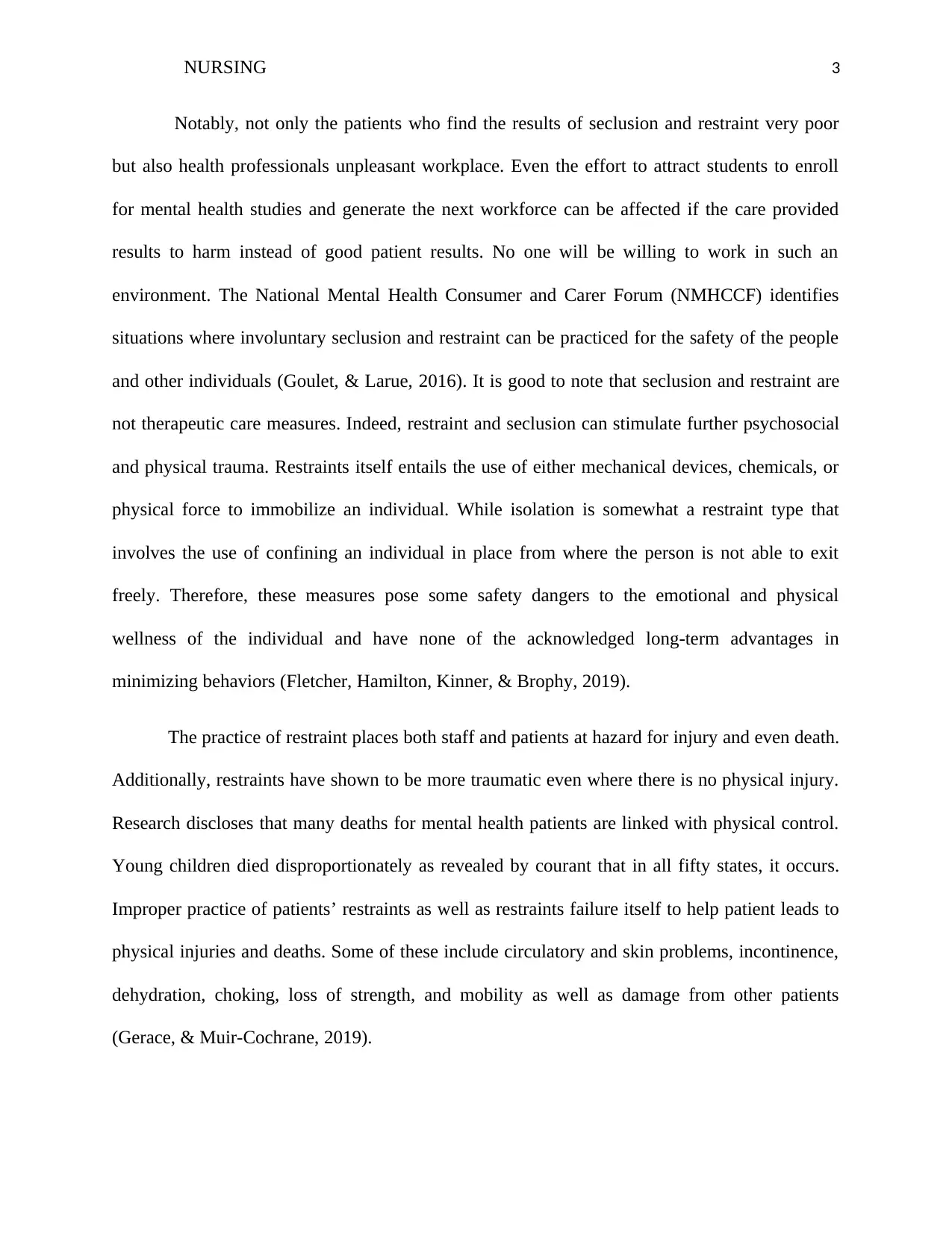
NURSING 3
Notably, not only the patients who find the results of seclusion and restraint very poor
but also health professionals unpleasant workplace. Even the effort to attract students to enroll
for mental health studies and generate the next workforce can be affected if the care provided
results to harm instead of good patient results. No one will be willing to work in such an
environment. The National Mental Health Consumer and Carer Forum (NMHCCF) identifies
situations where involuntary seclusion and restraint can be practiced for the safety of the people
and other individuals (Goulet, & Larue, 2016). It is good to note that seclusion and restraint are
not therapeutic care measures. Indeed, restraint and seclusion can stimulate further psychosocial
and physical trauma. Restraints itself entails the use of either mechanical devices, chemicals, or
physical force to immobilize an individual. While isolation is somewhat a restraint type that
involves the use of confining an individual in place from where the person is not able to exit
freely. Therefore, these measures pose some safety dangers to the emotional and physical
wellness of the individual and have none of the acknowledged long-term advantages in
minimizing behaviors (Fletcher, Hamilton, Kinner, & Brophy, 2019).
The practice of restraint places both staff and patients at hazard for injury and even death.
Additionally, restraints have shown to be more traumatic even where there is no physical injury.
Research discloses that many deaths for mental health patients are linked with physical control.
Young children died disproportionately as revealed by courant that in all fifty states, it occurs.
Improper practice of patients’ restraints as well as restraints failure itself to help patient leads to
physical injuries and deaths. Some of these include circulatory and skin problems, incontinence,
dehydration, choking, loss of strength, and mobility as well as damage from other patients
(Gerace, & Muir‐Cochrane, 2019).
Notably, not only the patients who find the results of seclusion and restraint very poor
but also health professionals unpleasant workplace. Even the effort to attract students to enroll
for mental health studies and generate the next workforce can be affected if the care provided
results to harm instead of good patient results. No one will be willing to work in such an
environment. The National Mental Health Consumer and Carer Forum (NMHCCF) identifies
situations where involuntary seclusion and restraint can be practiced for the safety of the people
and other individuals (Goulet, & Larue, 2016). It is good to note that seclusion and restraint are
not therapeutic care measures. Indeed, restraint and seclusion can stimulate further psychosocial
and physical trauma. Restraints itself entails the use of either mechanical devices, chemicals, or
physical force to immobilize an individual. While isolation is somewhat a restraint type that
involves the use of confining an individual in place from where the person is not able to exit
freely. Therefore, these measures pose some safety dangers to the emotional and physical
wellness of the individual and have none of the acknowledged long-term advantages in
minimizing behaviors (Fletcher, Hamilton, Kinner, & Brophy, 2019).
The practice of restraint places both staff and patients at hazard for injury and even death.
Additionally, restraints have shown to be more traumatic even where there is no physical injury.
Research discloses that many deaths for mental health patients are linked with physical control.
Young children died disproportionately as revealed by courant that in all fifty states, it occurs.
Improper practice of patients’ restraints as well as restraints failure itself to help patient leads to
physical injuries and deaths. Some of these include circulatory and skin problems, incontinence,
dehydration, choking, loss of strength, and mobility as well as damage from other patients
(Gerace, & Muir‐Cochrane, 2019).
⊘ This is a preview!⊘
Do you want full access?
Subscribe today to unlock all pages.

Trusted by 1+ million students worldwide
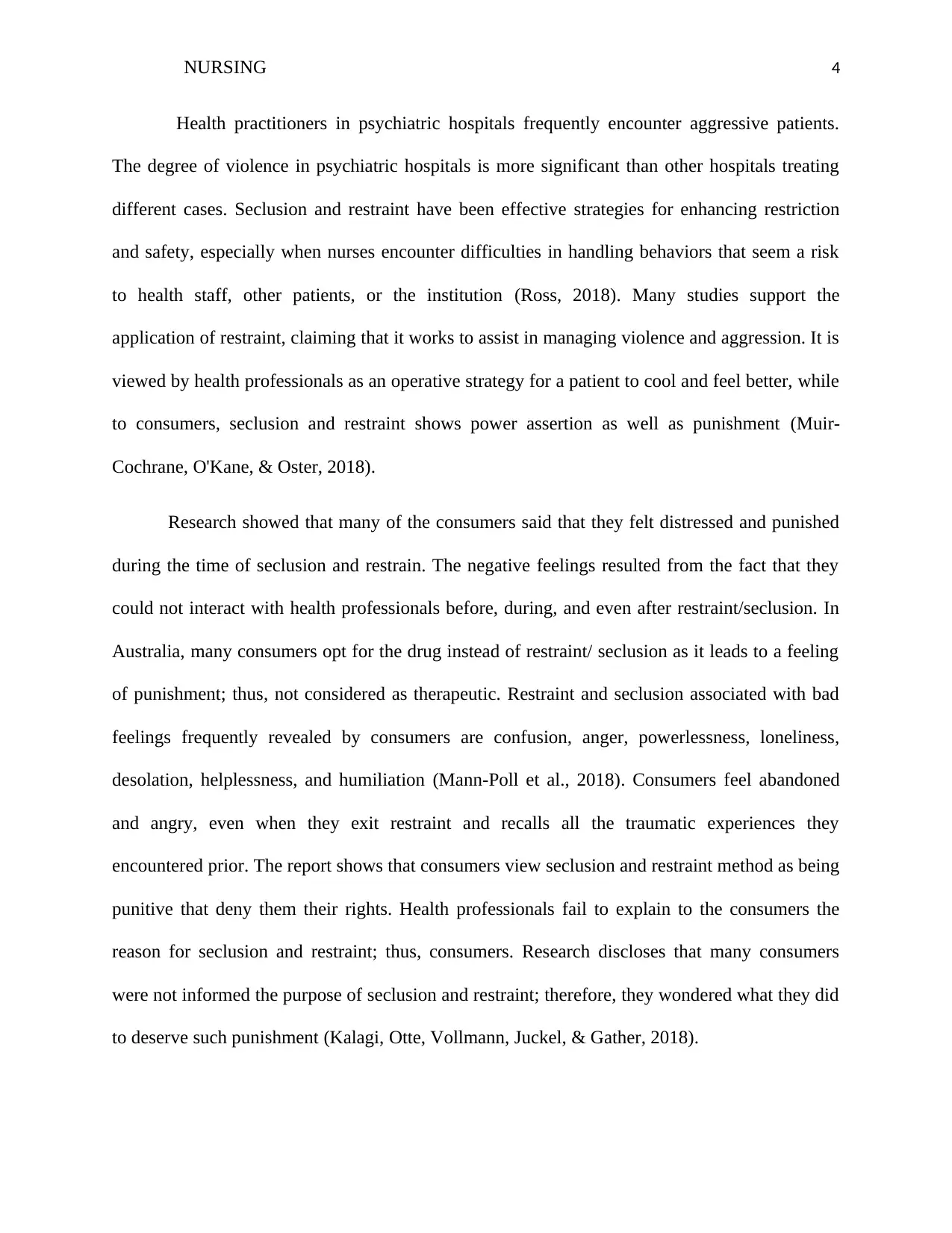
NURSING 4
Health practitioners in psychiatric hospitals frequently encounter aggressive patients.
The degree of violence in psychiatric hospitals is more significant than other hospitals treating
different cases. Seclusion and restraint have been effective strategies for enhancing restriction
and safety, especially when nurses encounter difficulties in handling behaviors that seem a risk
to health staff, other patients, or the institution (Ross, 2018). Many studies support the
application of restraint, claiming that it works to assist in managing violence and aggression. It is
viewed by health professionals as an operative strategy for a patient to cool and feel better, while
to consumers, seclusion and restraint shows power assertion as well as punishment (Muir‐
Cochrane, O'Kane, & Oster, 2018).
Research showed that many of the consumers said that they felt distressed and punished
during the time of seclusion and restrain. The negative feelings resulted from the fact that they
could not interact with health professionals before, during, and even after restraint/seclusion. In
Australia, many consumers opt for the drug instead of restraint/ seclusion as it leads to a feeling
of punishment; thus, not considered as therapeutic. Restraint and seclusion associated with bad
feelings frequently revealed by consumers are confusion, anger, powerlessness, loneliness,
desolation, helplessness, and humiliation (Mann-Poll et al., 2018). Consumers feel abandoned
and angry, even when they exit restraint and recalls all the traumatic experiences they
encountered prior. The report shows that consumers view seclusion and restraint method as being
punitive that deny them their rights. Health professionals fail to explain to the consumers the
reason for seclusion and restraint; thus, consumers. Research discloses that many consumers
were not informed the purpose of seclusion and restraint; therefore, they wondered what they did
to deserve such punishment (Kalagi, Otte, Vollmann, Juckel, & Gather, 2018).
Health practitioners in psychiatric hospitals frequently encounter aggressive patients.
The degree of violence in psychiatric hospitals is more significant than other hospitals treating
different cases. Seclusion and restraint have been effective strategies for enhancing restriction
and safety, especially when nurses encounter difficulties in handling behaviors that seem a risk
to health staff, other patients, or the institution (Ross, 2018). Many studies support the
application of restraint, claiming that it works to assist in managing violence and aggression. It is
viewed by health professionals as an operative strategy for a patient to cool and feel better, while
to consumers, seclusion and restraint shows power assertion as well as punishment (Muir‐
Cochrane, O'Kane, & Oster, 2018).
Research showed that many of the consumers said that they felt distressed and punished
during the time of seclusion and restrain. The negative feelings resulted from the fact that they
could not interact with health professionals before, during, and even after restraint/seclusion. In
Australia, many consumers opt for the drug instead of restraint/ seclusion as it leads to a feeling
of punishment; thus, not considered as therapeutic. Restraint and seclusion associated with bad
feelings frequently revealed by consumers are confusion, anger, powerlessness, loneliness,
desolation, helplessness, and humiliation (Mann-Poll et al., 2018). Consumers feel abandoned
and angry, even when they exit restraint and recalls all the traumatic experiences they
encountered prior. The report shows that consumers view seclusion and restraint method as being
punitive that deny them their rights. Health professionals fail to explain to the consumers the
reason for seclusion and restraint; thus, consumers. Research discloses that many consumers
were not informed the purpose of seclusion and restraint; therefore, they wondered what they did
to deserve such punishment (Kalagi, Otte, Vollmann, Juckel, & Gather, 2018).
Paraphrase This Document
Need a fresh take? Get an instant paraphrase of this document with our AI Paraphraser
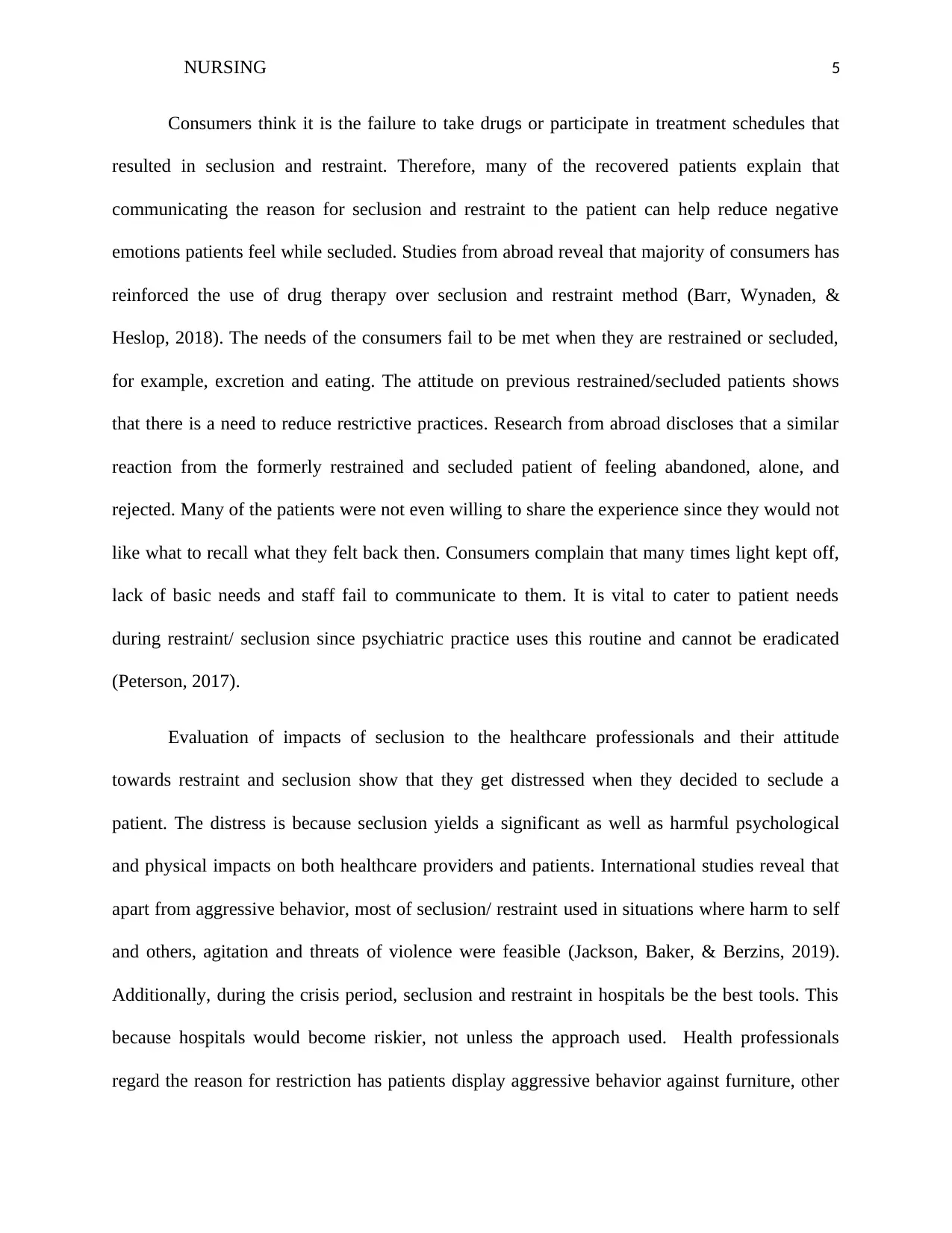
NURSING 5
Consumers think it is the failure to take drugs or participate in treatment schedules that
resulted in seclusion and restraint. Therefore, many of the recovered patients explain that
communicating the reason for seclusion and restraint to the patient can help reduce negative
emotions patients feel while secluded. Studies from abroad reveal that majority of consumers has
reinforced the use of drug therapy over seclusion and restraint method (Barr, Wynaden, &
Heslop, 2018). The needs of the consumers fail to be met when they are restrained or secluded,
for example, excretion and eating. The attitude on previous restrained/secluded patients shows
that there is a need to reduce restrictive practices. Research from abroad discloses that a similar
reaction from the formerly restrained and secluded patient of feeling abandoned, alone, and
rejected. Many of the patients were not even willing to share the experience since they would not
like what to recall what they felt back then. Consumers complain that many times light kept off,
lack of basic needs and staff fail to communicate to them. It is vital to cater to patient needs
during restraint/ seclusion since psychiatric practice uses this routine and cannot be eradicated
(Peterson, 2017).
Evaluation of impacts of seclusion to the healthcare professionals and their attitude
towards restraint and seclusion show that they get distressed when they decided to seclude a
patient. The distress is because seclusion yields a significant as well as harmful psychological
and physical impacts on both healthcare providers and patients. International studies reveal that
apart from aggressive behavior, most of seclusion/ restraint used in situations where harm to self
and others, agitation and threats of violence were feasible (Jackson, Baker, & Berzins, 2019).
Additionally, during the crisis period, seclusion and restraint in hospitals be the best tools. This
because hospitals would become riskier, not unless the approach used. Health professionals
regard the reason for restriction has patients display aggressive behavior against furniture, other
Consumers think it is the failure to take drugs or participate in treatment schedules that
resulted in seclusion and restraint. Therefore, many of the recovered patients explain that
communicating the reason for seclusion and restraint to the patient can help reduce negative
emotions patients feel while secluded. Studies from abroad reveal that majority of consumers has
reinforced the use of drug therapy over seclusion and restraint method (Barr, Wynaden, &
Heslop, 2018). The needs of the consumers fail to be met when they are restrained or secluded,
for example, excretion and eating. The attitude on previous restrained/secluded patients shows
that there is a need to reduce restrictive practices. Research from abroad discloses that a similar
reaction from the formerly restrained and secluded patient of feeling abandoned, alone, and
rejected. Many of the patients were not even willing to share the experience since they would not
like what to recall what they felt back then. Consumers complain that many times light kept off,
lack of basic needs and staff fail to communicate to them. It is vital to cater to patient needs
during restraint/ seclusion since psychiatric practice uses this routine and cannot be eradicated
(Peterson, 2017).
Evaluation of impacts of seclusion to the healthcare professionals and their attitude
towards restraint and seclusion show that they get distressed when they decided to seclude a
patient. The distress is because seclusion yields a significant as well as harmful psychological
and physical impacts on both healthcare providers and patients. International studies reveal that
apart from aggressive behavior, most of seclusion/ restraint used in situations where harm to self
and others, agitation and threats of violence were feasible (Jackson, Baker, & Berzins, 2019).
Additionally, during the crisis period, seclusion and restraint in hospitals be the best tools. This
because hospitals would become riskier, not unless the approach used. Health professionals
regard the reason for restriction has patients display aggressive behavior against furniture, other
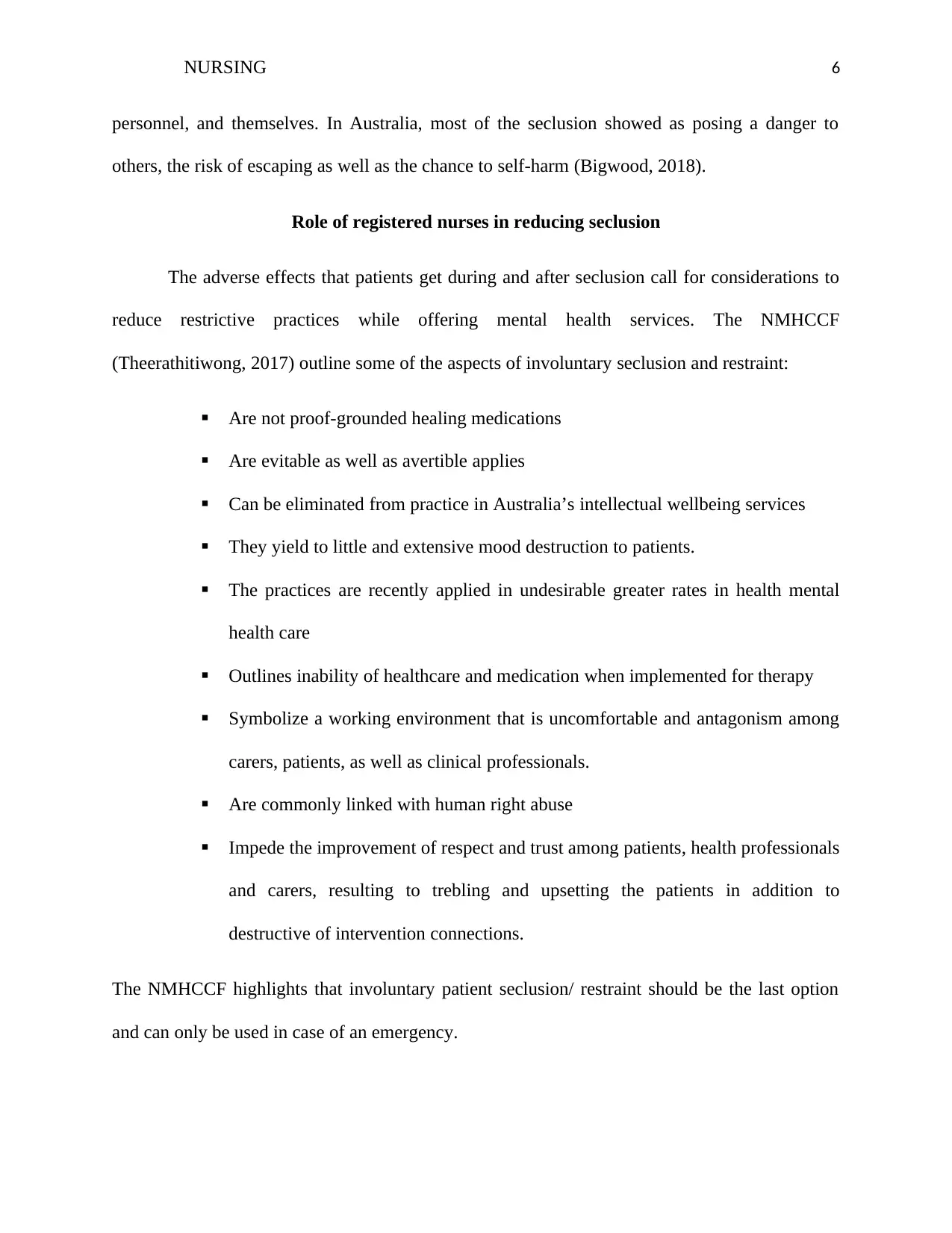
NURSING 6
personnel, and themselves. In Australia, most of the seclusion showed as posing a danger to
others, the risk of escaping as well as the chance to self-harm (Bigwood, 2018).
Role of registered nurses in reducing seclusion
The adverse effects that patients get during and after seclusion call for considerations to
reduce restrictive practices while offering mental health services. The NMHCCF
(Theerathitiwong, 2017) outline some of the aspects of involuntary seclusion and restraint:
Are not proof-grounded healing medications
Are evitable as well as avertible applies
Can be eliminated from practice in Australia’s intellectual wellbeing services
They yield to little and extensive mood destruction to patients.
The practices are recently applied in undesirable greater rates in health mental
health care
Outlines inability of healthcare and medication when implemented for therapy
Symbolize a working environment that is uncomfortable and antagonism among
carers, patients, as well as clinical professionals.
Are commonly linked with human right abuse
Impede the improvement of respect and trust among patients, health professionals
and carers, resulting to trebling and upsetting the patients in addition to
destructive of intervention connections.
The NMHCCF highlights that involuntary patient seclusion/ restraint should be the last option
and can only be used in case of an emergency.
personnel, and themselves. In Australia, most of the seclusion showed as posing a danger to
others, the risk of escaping as well as the chance to self-harm (Bigwood, 2018).
Role of registered nurses in reducing seclusion
The adverse effects that patients get during and after seclusion call for considerations to
reduce restrictive practices while offering mental health services. The NMHCCF
(Theerathitiwong, 2017) outline some of the aspects of involuntary seclusion and restraint:
Are not proof-grounded healing medications
Are evitable as well as avertible applies
Can be eliminated from practice in Australia’s intellectual wellbeing services
They yield to little and extensive mood destruction to patients.
The practices are recently applied in undesirable greater rates in health mental
health care
Outlines inability of healthcare and medication when implemented for therapy
Symbolize a working environment that is uncomfortable and antagonism among
carers, patients, as well as clinical professionals.
Are commonly linked with human right abuse
Impede the improvement of respect and trust among patients, health professionals
and carers, resulting to trebling and upsetting the patients in addition to
destructive of intervention connections.
The NMHCCF highlights that involuntary patient seclusion/ restraint should be the last option
and can only be used in case of an emergency.
⊘ This is a preview!⊘
Do you want full access?
Subscribe today to unlock all pages.

Trusted by 1+ million students worldwide
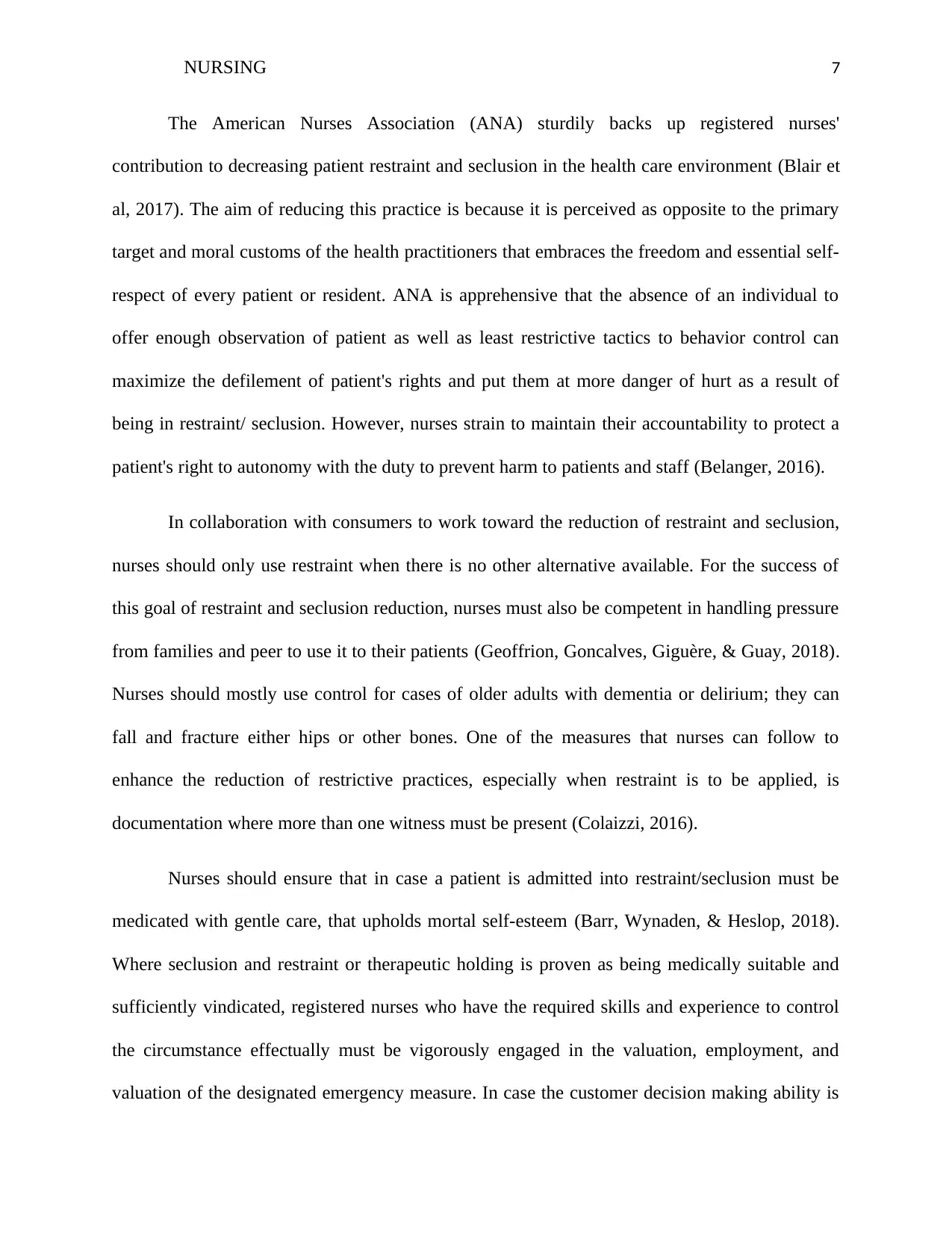
NURSING 7
The American Nurses Association (ANA) sturdily backs up registered nurses'
contribution to decreasing patient restraint and seclusion in the health care environment (Blair et
al, 2017). The aim of reducing this practice is because it is perceived as opposite to the primary
target and moral customs of the health practitioners that embraces the freedom and essential self-
respect of every patient or resident. ANA is apprehensive that the absence of an individual to
offer enough observation of patient as well as least restrictive tactics to behavior control can
maximize the defilement of patient's rights and put them at more danger of hurt as a result of
being in restraint/ seclusion. However, nurses strain to maintain their accountability to protect a
patient's right to autonomy with the duty to prevent harm to patients and staff (Belanger, 2016).
In collaboration with consumers to work toward the reduction of restraint and seclusion,
nurses should only use restraint when there is no other alternative available. For the success of
this goal of restraint and seclusion reduction, nurses must also be competent in handling pressure
from families and peer to use it to their patients (Geoffrion, Goncalves, Giguère, & Guay, 2018).
Nurses should mostly use control for cases of older adults with dementia or delirium; they can
fall and fracture either hips or other bones. One of the measures that nurses can follow to
enhance the reduction of restrictive practices, especially when restraint is to be applied, is
documentation where more than one witness must be present (Colaizzi, 2016).
Nurses should ensure that in case a patient is admitted into restraint/seclusion must be
medicated with gentle care, that upholds mortal self-esteem (Barr, Wynaden, & Heslop, 2018).
Where seclusion and restraint or therapeutic holding is proven as being medically suitable and
sufficiently vindicated, registered nurses who have the required skills and experience to control
the circumstance effectually must be vigorously engaged in the valuation, employment, and
valuation of the designated emergency measure. In case the customer decision making ability is
The American Nurses Association (ANA) sturdily backs up registered nurses'
contribution to decreasing patient restraint and seclusion in the health care environment (Blair et
al, 2017). The aim of reducing this practice is because it is perceived as opposite to the primary
target and moral customs of the health practitioners that embraces the freedom and essential self-
respect of every patient or resident. ANA is apprehensive that the absence of an individual to
offer enough observation of patient as well as least restrictive tactics to behavior control can
maximize the defilement of patient's rights and put them at more danger of hurt as a result of
being in restraint/ seclusion. However, nurses strain to maintain their accountability to protect a
patient's right to autonomy with the duty to prevent harm to patients and staff (Belanger, 2016).
In collaboration with consumers to work toward the reduction of restraint and seclusion,
nurses should only use restraint when there is no other alternative available. For the success of
this goal of restraint and seclusion reduction, nurses must also be competent in handling pressure
from families and peer to use it to their patients (Geoffrion, Goncalves, Giguère, & Guay, 2018).
Nurses should mostly use control for cases of older adults with dementia or delirium; they can
fall and fracture either hips or other bones. One of the measures that nurses can follow to
enhance the reduction of restrictive practices, especially when restraint is to be applied, is
documentation where more than one witness must be present (Colaizzi, 2016).
Nurses should ensure that in case a patient is admitted into restraint/seclusion must be
medicated with gentle care, that upholds mortal self-esteem (Barr, Wynaden, & Heslop, 2018).
Where seclusion and restraint or therapeutic holding is proven as being medically suitable and
sufficiently vindicated, registered nurses who have the required skills and experience to control
the circumstance effectually must be vigorously engaged in the valuation, employment, and
valuation of the designated emergency measure. In case the customer decision making ability is
Paraphrase This Document
Need a fresh take? Get an instant paraphrase of this document with our AI Paraphraser
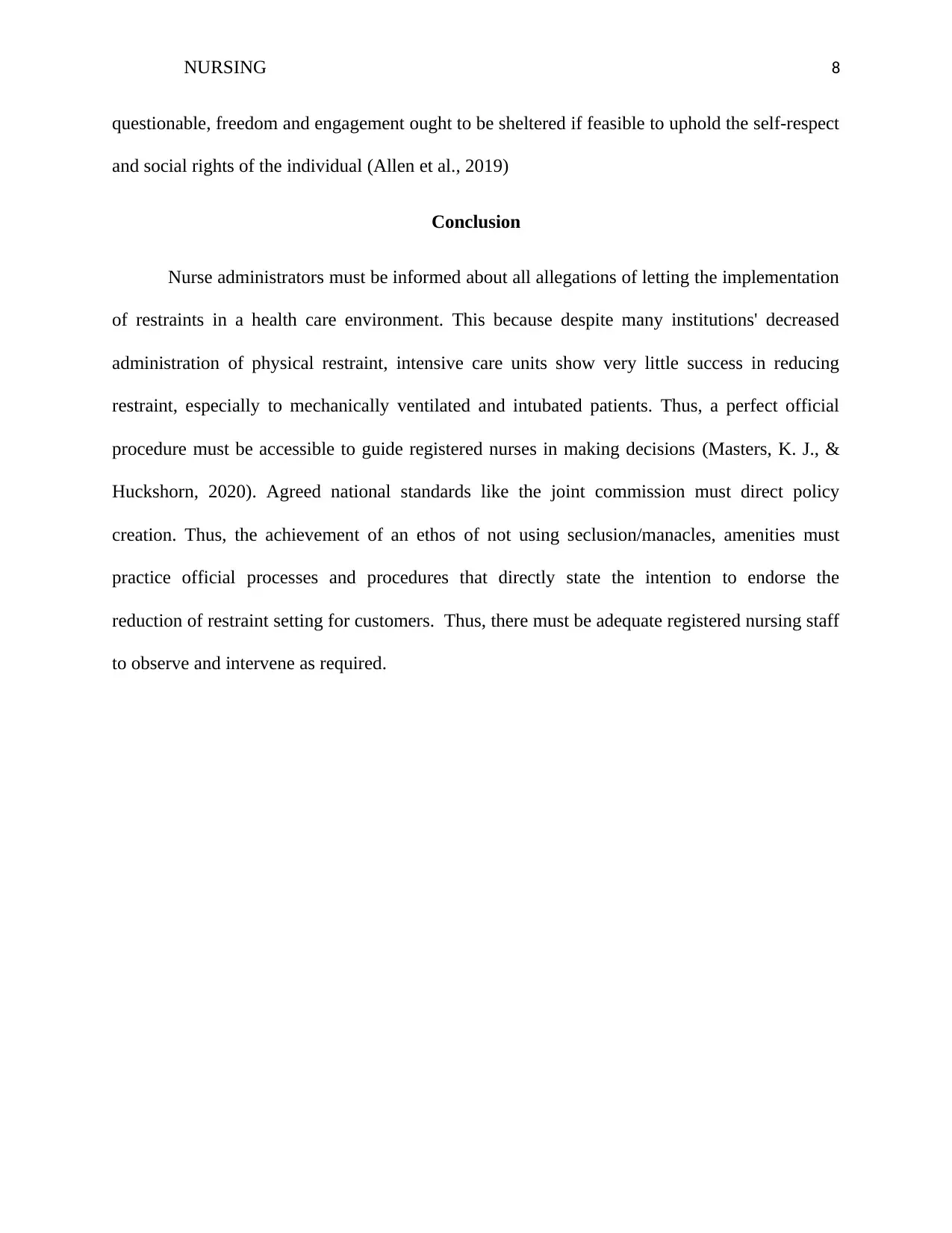
NURSING 8
questionable, freedom and engagement ought to be sheltered if feasible to uphold the self-respect
and social rights of the individual (Allen et al., 2019)
Conclusion
Nurse administrators must be informed about all allegations of letting the implementation
of restraints in a health care environment. This because despite many institutions' decreased
administration of physical restraint, intensive care units show very little success in reducing
restraint, especially to mechanically ventilated and intubated patients. Thus, a perfect official
procedure must be accessible to guide registered nurses in making decisions (Masters, K. J., &
Huckshorn, 2020). Agreed national standards like the joint commission must direct policy
creation. Thus, the achievement of an ethos of not using seclusion/manacles, amenities must
practice official processes and procedures that directly state the intention to endorse the
reduction of restraint setting for customers. Thus, there must be adequate registered nursing staff
to observe and intervene as required.
questionable, freedom and engagement ought to be sheltered if feasible to uphold the self-respect
and social rights of the individual (Allen et al., 2019)
Conclusion
Nurse administrators must be informed about all allegations of letting the implementation
of restraints in a health care environment. This because despite many institutions' decreased
administration of physical restraint, intensive care units show very little success in reducing
restraint, especially to mechanically ventilated and intubated patients. Thus, a perfect official
procedure must be accessible to guide registered nurses in making decisions (Masters, K. J., &
Huckshorn, 2020). Agreed national standards like the joint commission must direct policy
creation. Thus, the achievement of an ethos of not using seclusion/manacles, amenities must
practice official processes and procedures that directly state the intention to endorse the
reduction of restraint setting for customers. Thus, there must be adequate registered nursing staff
to observe and intervene as required.
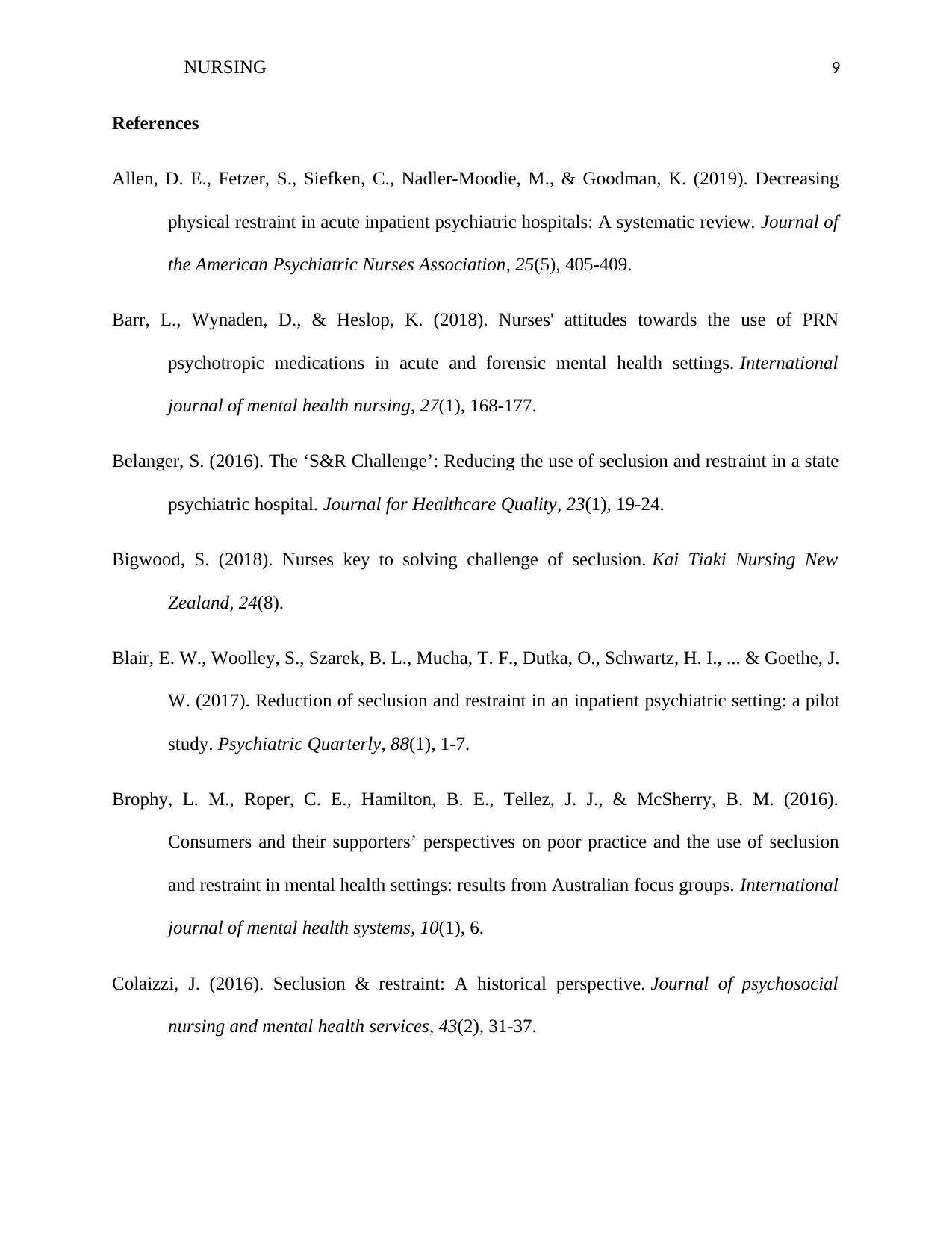
NURSING 9
References
Allen, D. E., Fetzer, S., Siefken, C., Nadler-Moodie, M., & Goodman, K. (2019). Decreasing
physical restraint in acute inpatient psychiatric hospitals: A systematic review. Journal of
the American Psychiatric Nurses Association, 25(5), 405-409.
Barr, L., Wynaden, D., & Heslop, K. (2018). Nurses' attitudes towards the use of PRN
psychotropic medications in acute and forensic mental health settings. International
journal of mental health nursing, 27(1), 168-177.
Belanger, S. (2016). The ‘S&R Challenge’: Reducing the use of seclusion and restraint in a state
psychiatric hospital. Journal for Healthcare Quality, 23(1), 19-24.
Bigwood, S. (2018). Nurses key to solving challenge of seclusion. Kai Tiaki Nursing New
Zealand, 24(8).
Blair, E. W., Woolley, S., Szarek, B. L., Mucha, T. F., Dutka, O., Schwartz, H. I., ... & Goethe, J.
W. (2017). Reduction of seclusion and restraint in an inpatient psychiatric setting: a pilot
study. Psychiatric Quarterly, 88(1), 1-7.
Brophy, L. M., Roper, C. E., Hamilton, B. E., Tellez, J. J., & McSherry, B. M. (2016).
Consumers and their supporters’ perspectives on poor practice and the use of seclusion
and restraint in mental health settings: results from Australian focus groups. International
journal of mental health systems, 10(1), 6.
Colaizzi, J. (2016). Seclusion & restraint: A historical perspective. Journal of psychosocial
nursing and mental health services, 43(2), 31-37.
References
Allen, D. E., Fetzer, S., Siefken, C., Nadler-Moodie, M., & Goodman, K. (2019). Decreasing
physical restraint in acute inpatient psychiatric hospitals: A systematic review. Journal of
the American Psychiatric Nurses Association, 25(5), 405-409.
Barr, L., Wynaden, D., & Heslop, K. (2018). Nurses' attitudes towards the use of PRN
psychotropic medications in acute and forensic mental health settings. International
journal of mental health nursing, 27(1), 168-177.
Belanger, S. (2016). The ‘S&R Challenge’: Reducing the use of seclusion and restraint in a state
psychiatric hospital. Journal for Healthcare Quality, 23(1), 19-24.
Bigwood, S. (2018). Nurses key to solving challenge of seclusion. Kai Tiaki Nursing New
Zealand, 24(8).
Blair, E. W., Woolley, S., Szarek, B. L., Mucha, T. F., Dutka, O., Schwartz, H. I., ... & Goethe, J.
W. (2017). Reduction of seclusion and restraint in an inpatient psychiatric setting: a pilot
study. Psychiatric Quarterly, 88(1), 1-7.
Brophy, L. M., Roper, C. E., Hamilton, B. E., Tellez, J. J., & McSherry, B. M. (2016).
Consumers and their supporters’ perspectives on poor practice and the use of seclusion
and restraint in mental health settings: results from Australian focus groups. International
journal of mental health systems, 10(1), 6.
Colaizzi, J. (2016). Seclusion & restraint: A historical perspective. Journal of psychosocial
nursing and mental health services, 43(2), 31-37.
⊘ This is a preview!⊘
Do you want full access?
Subscribe today to unlock all pages.

Trusted by 1+ million students worldwide
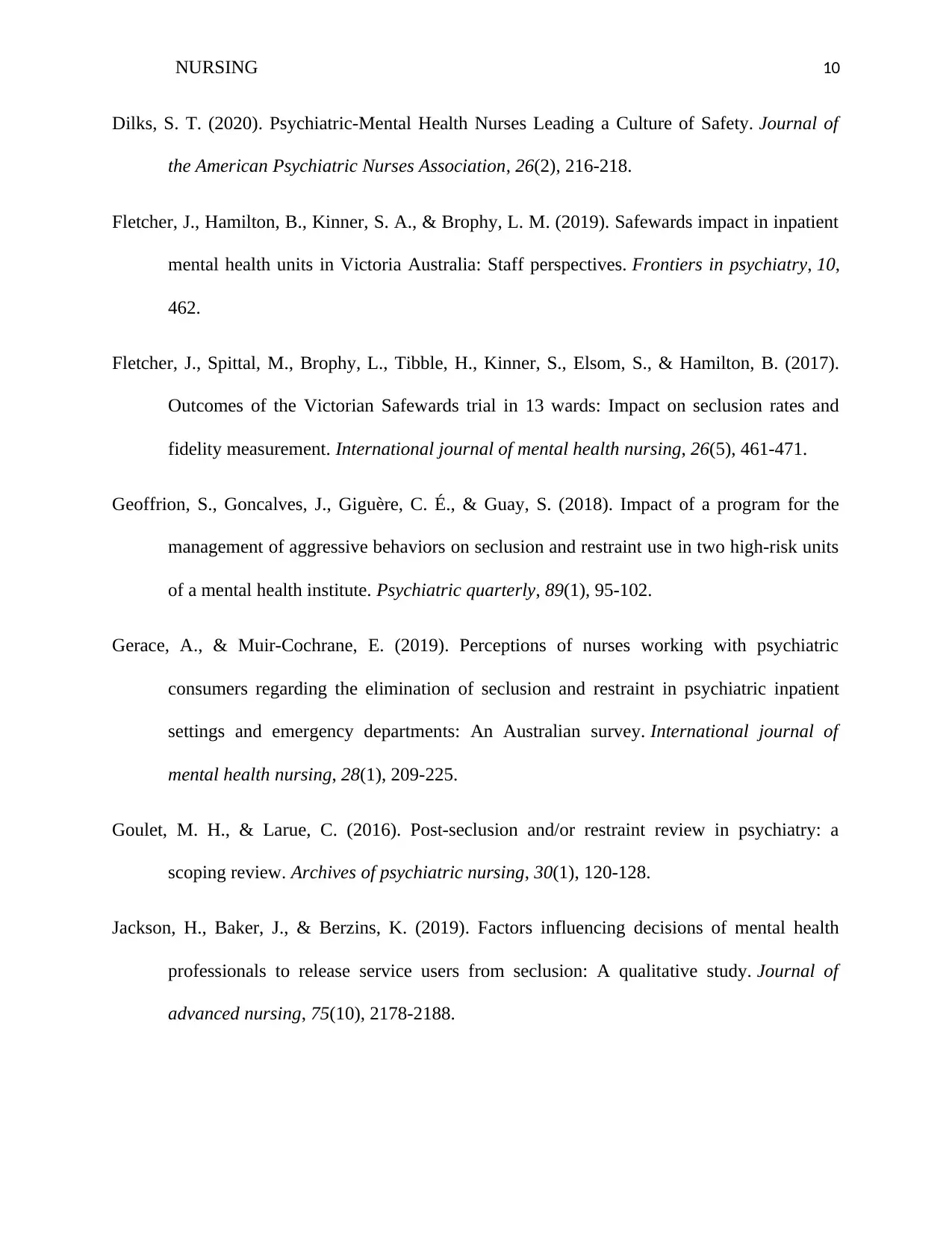
NURSING 10
Dilks, S. T. (2020). Psychiatric-Mental Health Nurses Leading a Culture of Safety. Journal of
the American Psychiatric Nurses Association, 26(2), 216-218.
Fletcher, J., Hamilton, B., Kinner, S. A., & Brophy, L. M. (2019). Safewards impact in inpatient
mental health units in Victoria Australia: Staff perspectives. Frontiers in psychiatry, 10,
462.
Fletcher, J., Spittal, M., Brophy, L., Tibble, H., Kinner, S., Elsom, S., & Hamilton, B. (2017).
Outcomes of the Victorian Safewards trial in 13 wards: Impact on seclusion rates and
fidelity measurement. International journal of mental health nursing, 26(5), 461-471.
Geoffrion, S., Goncalves, J., Giguère, C. É., & Guay, S. (2018). Impact of a program for the
management of aggressive behaviors on seclusion and restraint use in two high-risk units
of a mental health institute. Psychiatric quarterly, 89(1), 95-102.
Gerace, A., & Muir‐Cochrane, E. (2019). Perceptions of nurses working with psychiatric
consumers regarding the elimination of seclusion and restraint in psychiatric inpatient
settings and emergency departments: An Australian survey. International journal of
mental health nursing, 28(1), 209-225.
Goulet, M. H., & Larue, C. (2016). Post-seclusion and/or restraint review in psychiatry: a
scoping review. Archives of psychiatric nursing, 30(1), 120-128.
Jackson, H., Baker, J., & Berzins, K. (2019). Factors influencing decisions of mental health
professionals to release service users from seclusion: A qualitative study. Journal of
advanced nursing, 75(10), 2178-2188.
Dilks, S. T. (2020). Psychiatric-Mental Health Nurses Leading a Culture of Safety. Journal of
the American Psychiatric Nurses Association, 26(2), 216-218.
Fletcher, J., Hamilton, B., Kinner, S. A., & Brophy, L. M. (2019). Safewards impact in inpatient
mental health units in Victoria Australia: Staff perspectives. Frontiers in psychiatry, 10,
462.
Fletcher, J., Spittal, M., Brophy, L., Tibble, H., Kinner, S., Elsom, S., & Hamilton, B. (2017).
Outcomes of the Victorian Safewards trial in 13 wards: Impact on seclusion rates and
fidelity measurement. International journal of mental health nursing, 26(5), 461-471.
Geoffrion, S., Goncalves, J., Giguère, C. É., & Guay, S. (2018). Impact of a program for the
management of aggressive behaviors on seclusion and restraint use in two high-risk units
of a mental health institute. Psychiatric quarterly, 89(1), 95-102.
Gerace, A., & Muir‐Cochrane, E. (2019). Perceptions of nurses working with psychiatric
consumers regarding the elimination of seclusion and restraint in psychiatric inpatient
settings and emergency departments: An Australian survey. International journal of
mental health nursing, 28(1), 209-225.
Goulet, M. H., & Larue, C. (2016). Post-seclusion and/or restraint review in psychiatry: a
scoping review. Archives of psychiatric nursing, 30(1), 120-128.
Jackson, H., Baker, J., & Berzins, K. (2019). Factors influencing decisions of mental health
professionals to release service users from seclusion: A qualitative study. Journal of
advanced nursing, 75(10), 2178-2188.
Paraphrase This Document
Need a fresh take? Get an instant paraphrase of this document with our AI Paraphraser
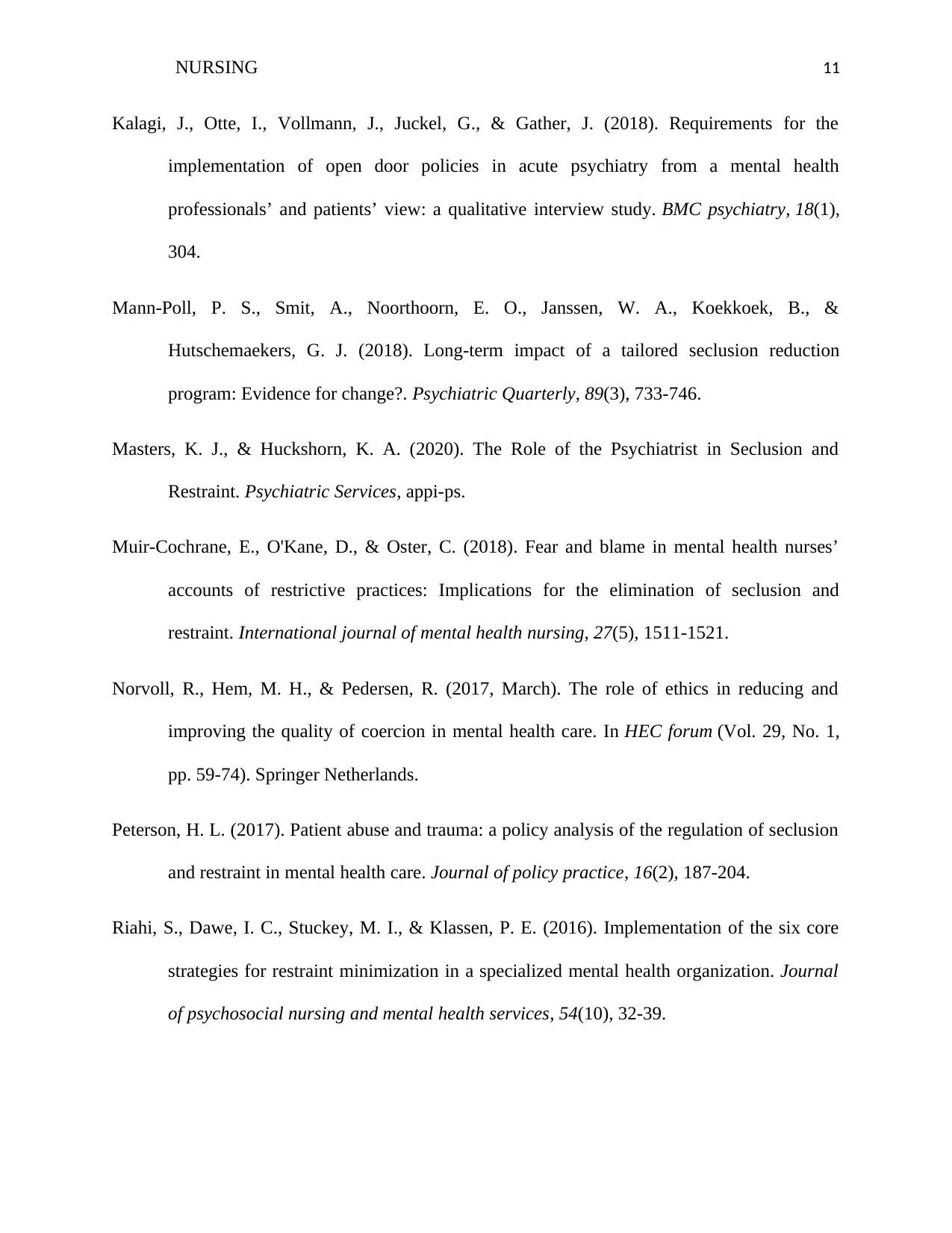
NURSING 11
Kalagi, J., Otte, I., Vollmann, J., Juckel, G., & Gather, J. (2018). Requirements for the
implementation of open door policies in acute psychiatry from a mental health
professionals’ and patients’ view: a qualitative interview study. BMC psychiatry, 18(1),
304.
Mann-Poll, P. S., Smit, A., Noorthoorn, E. O., Janssen, W. A., Koekkoek, B., &
Hutschemaekers, G. J. (2018). Long-term impact of a tailored seclusion reduction
program: Evidence for change?. Psychiatric Quarterly, 89(3), 733-746.
Masters, K. J., & Huckshorn, K. A. (2020). The Role of the Psychiatrist in Seclusion and
Restraint. Psychiatric Services, appi-ps.
Muir‐Cochrane, E., O'Kane, D., & Oster, C. (2018). Fear and blame in mental health nurses’
accounts of restrictive practices: Implications for the elimination of seclusion and
restraint. International journal of mental health nursing, 27(5), 1511-1521.
Norvoll, R., Hem, M. H., & Pedersen, R. (2017, March). The role of ethics in reducing and
improving the quality of coercion in mental health care. In HEC forum (Vol. 29, No. 1,
pp. 59-74). Springer Netherlands.
Peterson, H. L. (2017). Patient abuse and trauma: a policy analysis of the regulation of seclusion
and restraint in mental health care. Journal of policy practice, 16(2), 187-204.
Riahi, S., Dawe, I. C., Stuckey, M. I., & Klassen, P. E. (2016). Implementation of the six core
strategies for restraint minimization in a specialized mental health organization. Journal
of psychosocial nursing and mental health services, 54(10), 32-39.
Kalagi, J., Otte, I., Vollmann, J., Juckel, G., & Gather, J. (2018). Requirements for the
implementation of open door policies in acute psychiatry from a mental health
professionals’ and patients’ view: a qualitative interview study. BMC psychiatry, 18(1),
304.
Mann-Poll, P. S., Smit, A., Noorthoorn, E. O., Janssen, W. A., Koekkoek, B., &
Hutschemaekers, G. J. (2018). Long-term impact of a tailored seclusion reduction
program: Evidence for change?. Psychiatric Quarterly, 89(3), 733-746.
Masters, K. J., & Huckshorn, K. A. (2020). The Role of the Psychiatrist in Seclusion and
Restraint. Psychiatric Services, appi-ps.
Muir‐Cochrane, E., O'Kane, D., & Oster, C. (2018). Fear and blame in mental health nurses’
accounts of restrictive practices: Implications for the elimination of seclusion and
restraint. International journal of mental health nursing, 27(5), 1511-1521.
Norvoll, R., Hem, M. H., & Pedersen, R. (2017, March). The role of ethics in reducing and
improving the quality of coercion in mental health care. In HEC forum (Vol. 29, No. 1,
pp. 59-74). Springer Netherlands.
Peterson, H. L. (2017). Patient abuse and trauma: a policy analysis of the regulation of seclusion
and restraint in mental health care. Journal of policy practice, 16(2), 187-204.
Riahi, S., Dawe, I. C., Stuckey, M. I., & Klassen, P. E. (2016). Implementation of the six core
strategies for restraint minimization in a specialized mental health organization. Journal
of psychosocial nursing and mental health services, 54(10), 32-39.
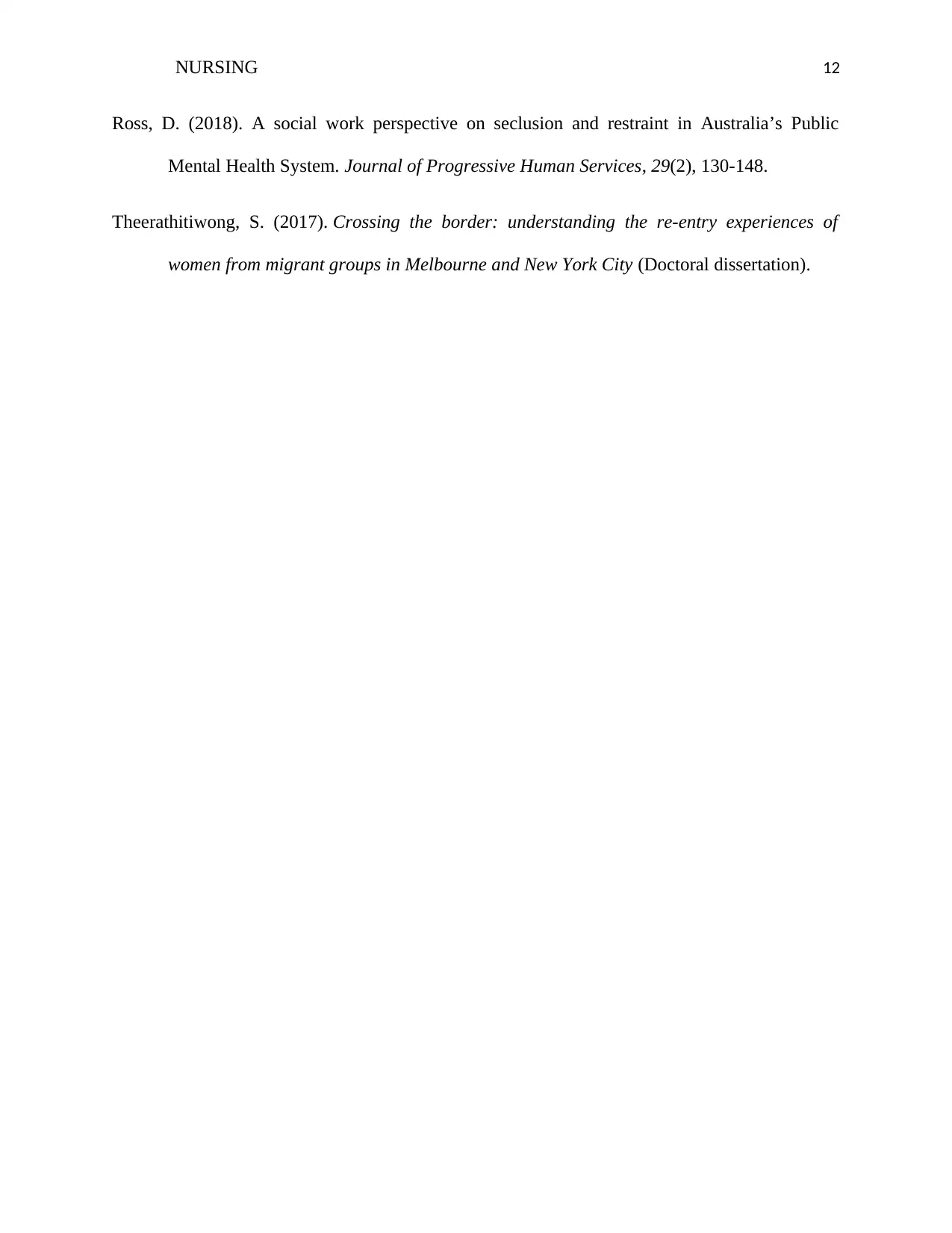
NURSING 12
Ross, D. (2018). A social work perspective on seclusion and restraint in Australia’s Public
Mental Health System. Journal of Progressive Human Services, 29(2), 130-148.
Theerathitiwong, S. (2017). Crossing the border: understanding the re-entry experiences of
women from migrant groups in Melbourne and New York City (Doctoral dissertation).
Ross, D. (2018). A social work perspective on seclusion and restraint in Australia’s Public
Mental Health System. Journal of Progressive Human Services, 29(2), 130-148.
Theerathitiwong, S. (2017). Crossing the border: understanding the re-entry experiences of
women from migrant groups in Melbourne and New York City (Doctoral dissertation).
⊘ This is a preview!⊘
Do you want full access?
Subscribe today to unlock all pages.

Trusted by 1+ million students worldwide
1 out of 12
Related Documents
Your All-in-One AI-Powered Toolkit for Academic Success.
+13062052269
info@desklib.com
Available 24*7 on WhatsApp / Email
![[object Object]](/_next/static/media/star-bottom.7253800d.svg)
Unlock your academic potential
Copyright © 2020–2025 A2Z Services. All Rights Reserved. Developed and managed by ZUCOL.





